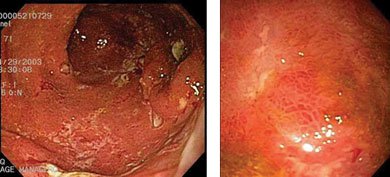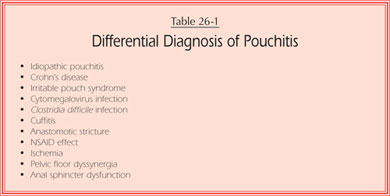How Do You Treat Pouchitis?
Total abdominal colectomy with ileal-pouch anal anastomosis (IPAA) has become the main surgical alternative for medically refractory ulcerative colitis (UC), UC with dysplasia, and familial adenomatous polyposis (FAP) over the past 2 decades. It is estimated that up to 60% of patients who undergo this procedure for UC will experience at least one episode of pouchitis (Figure 26-1).1 Patients with FAP rarely undergo this complication of IPAA. Patients typically present with an increased stool frequency, pelvic discomfort, urgency, and, occasionally, stool leakage and rectal bleeding. Although the etiology of pouchitis is unknown, most studies suggest that there is an abnormal immune response to the pouch microflora, which leads to both acute and chronic inflammation. Approaches to the treatment of pouchitis have involved the manipulation of both the pouch microflora and the mucosal immune system.

Figure 26-1. Pouchitis, endoscopically, is characterized by granularity, friability, and ulceration of the ileal pouch.
In a patient presenting with symptoms of pouchitis, the first thing that should be done is to confirm the diagnosis with an endoscopic exam of the ileal pouch.2 Motility disturbances of the pouch (irritable pouch syndrome [IPS]) and inflammation of the cuff (cuffitis) can mimic symptoms of pouchitis, but require different therapies (Table 26-1). In addition, it is not uncommon for patients, initially felt to have UC prior to colectomy, to develop inflammatory changes above the pouch more consistent with Crohn’s disease (CD). The approach to therapy in this population is to use treatment regimens directed at the CD and not the pouchitis. The second issue to explore is the use of non-steroidal anti-inflammatory drugs (NSAIDs). NSAID use can present a picture in the ileal pouch suggestive of pouchitis. This entity responds to discontinuing NSAIDs.3

Once pouchitis is established, the next step is to define the process as acute pouchitis, acute recurrent pouchitis, or chronic pouchitis. If this is the first bout of pouchitis, this distinction may not be possible, but will evolve over time.
In a patient presenting with a first episode of acute pouchitis, antibiotics are the mainstay of therapy, although optimal treatment regimens remain to be defined. My practice is to start with a metronidazole 500 mg bid (twice a day) and, if not tolerated, then switch to a ciprofloxacin 500 mg bid. Small, controlled clinical trials have been performed demonstrating the benefit of short-term treatment with metronidazole and ciprofloxacin, with some suggestion that ciprofloxacin had fewer side effects.4 Metronidazole therapy has also been compared in a controlled fashion to budesonide enemas with similar efficacy reported. Uncontrolled studies have reported beneficial responses in patients with pouchitis to erythromycin, tetracycline, rifaximin, and amoxicillin/clavulanate.1 Patients who cannot tolerate the systemic side effects of metronidazole at a dose of 750 to 1500 mg/day may tolerate a low dose of metronidazole at 70 to 300 mg/day given topically bid into the pouch in the form of a formulated suppository or a vaginal gel. With the first bout of pouchitis, or in patients with recurrent acute pouchitis that is infrequent, I typically treat for 14 days. The length of treatment varies in the reported controlled and uncontrolled trials from as few as 7 days up to 30 days. Rifaximin and other non-absorbable antibiotics have a theoretic advance of little or no systemic absorption leading to systemic side effects. Although large scale, rigorous, controlled trials have not been performed with rifaximin, I will use this as an alternative to metronidazole and ciprofloxacin in patients who are poorly tolerant of these drugs. The doses that have been used in clinical trials and open label studies range from 400 mg tid (three times a day) to 1 gram bid.
Chronic pouchitis is much more of a management problem in many patients. In patients who respond readily to a course of antibiotics but develop recurrent symptoms off of the antibiotics, the common practice is to treat chronically with the antibiotic that induced a resolution of the symptoms. Some patients are able to maintain remission on lower doses of antibiotics than on that needed to induce remission. Metronidazole is associated with more short-term and long-term side effects than is ciprofloxacin, limiting its use chronically. Short-term side effects include nausea, vomiting, abdominal pain, metallic taste in the mouth, headache, and rash. Peripheral neuropathy can occur with long-term use and may be irreversible. The most common antibiotic regimens used for chronic pouchitis are ciprofloxacin 250 to 500 mg/day and metronidazole 500 mg/day. Patients on maintenance antibiotics who lose response may respond to rotating antibiotics in 1 to 3 week intervals (eg, 3 weeks of metronidazole, followed by 3 weeks of ciprofloxacin, and then 3 weeks of rifaximin.) Short-term combination antibiotics such as ciprofloxacin/metronidazole or ciprofloxacin/rifaximin may also re-induce remission in patients who lose response to a single antibiotic.
With concerns about the chronic use of systemically absorbed antibiotics in patients with chronic pouchitis, alternative approaches to management should be considered. Non-absorbable antibiotics such as rifaximin may play a role, but they have only been studied adequately in a controlled fashion as combination therapy with ciprofloxacin in patients with chronic refractory pouchitis. Probiotics have received much attention as a means of altering the pouch flora and maintaining remission in chronic pouchitis. Oral probiotics containing strains of lactobacilli, bifidobacteria, and streptococcus (VSL#3; Sigma-Tau Pharmaceuticals, Inc., Gaithersburg, MD) have the most trial data to support their use.5,6 Open label clinical experience is encouraging. Patients are first treated with an antibiotic course to induce remission, and then the probiotic combination is added and administered chronically after the antibiotic course is completed. I will try this approach in patients with chronic pouchitis who are willing to take a daily probiotic supplement. My practice is to give 1 packet of VSL#3 tid, or a twice-daily dosing of an alternative probiotic that contains multiple strains of probiotic organisms.
If antibiotics or antibiotic/probiotic combinations are not successful in managing pouchitis symptoms, the diagnosis should again be questioned. In patients who clearly have continued active pouchitis, budesonide may play a role in treating active inflammation. Two mg budesonide enemas have demonstrated efficacy in clinical trials, but are not readily available in the United States. An alternative is to start 9 mg/day of oral budesonide and taper down to the lowest dose possible to manage symptoms. These patients will require attention to bone health with calcium and vitamin D supplementation, as well as with monitoring bone density. Topical therapy with mesalamine has not been found to be routinely effective in the treatment of acute or chronic pouchitis.
In patients who continue to have refractory pouchitis, there are anectodotal reports of the efficacy of immunomodulators such as 6-mercaptopurine (6-MP)/azathioprine and infliximab.2 These agents have not been subject to randomized controlled trials. However, since the alternative of removing the pouch and creating an end ileostomy is not acceptable to many patients, I have used these agents with some success. The dosing is the same as what would be used to treat CD—1 to 1.5 mg/kg of 6-MP, 2 to 2.5 mg/kg of azathioprine, and 5 mg/kg of infliximab per 2 months.
Overall, pouchitis is a common and often frustrating disease entity to treat. Accurate diagnosis and initial treatment with antibiotics should be undertaken. For patients with chronic pouchitis, long-term low-dose antibiotics or antibiotics followed by probiotics should be considered. In patients who continue to have problems, oral budesonide may control symptoms. In patients who continue to have refractory disease, immunosuppression or immunomodulation with 6-MP, azathioprine, or infliximab can be considered. Rarely, the patient may require resection of the ileal pouch with the creation of an end-ileostomy.
References
1. Pardi DS, Sandborn WJ. Systematic review: the management of pouchitis. Aliment Pharmacol Ther. 2006;23(8):1087-1096.
2. Pardi DS, Shen B. Endoscopy in the management of patients after ileal pouch surgery for ulcerative colitis. Endoscopy. 2008;40(6):529-533.
3. Shen B, Fazio VW, Remzi FH. Effect of withdrawal of nonsteroidal anti-inflammatory drug use on ileal pouch disorders. Digestive Diseases and Sciences. 2007;52(12):3321-3328.
4. Shen B, Achkar JP, Lashner BA, et al. A randomized clinical trial of ciprofloxacin and metronidazole to treat acute pouchitis. Inflamm Bowel Dis. 2001;7(4):301-305.
5. Gionchetti PP. Oral bacteriotherapy as maintenance treatment in patients with chronic pouchitis: a double-blind, placebo-controlled trial. Gastroenterology. 2000;119(2):594-587.
6. Gionchetti PP, Rizzello F, Morselli C, et al. High-dose probiotics for the treatment of active pouchitis diseases of the colon and rectum. 2007;50(12):2075-2084.
